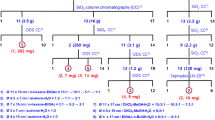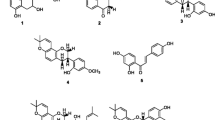Abstract
Repeated column chromatography of the CHCI3-soluble fraction ofZingiber zerumbet led to the isolation and identification of two aromatic compounds,p-hydroxybenzaldehyde (1) and vanillin (2), and six kaempferol derivatives, kaempferol-3,4′,7-O-trimethylether (3), kaempferol-3-O-methylether (4), kaempferol-3,4′-O-dimethylether (5), 4″-O-acetylafzelin (6), kaempferol-3-O-(4-O-acetyl-α-L-rhamnopyranoside)], 2″,4″-O-diacetylafzelin (7), kaempferol-3-O-(2,4-O-diacetyl-α-L-rhamnopyranoside)], and 3″,4″-O-diacetylafzelin (8), kaempferol-3-O-(3,4-O-diacetyl-α-L-rhamnopyranoside)]. The structures of1–8 were identified by analysis of spectro-scopic data as well as by comparison with published values. This is the first report on the isolation of compounds1–3 from this plant.
Similar content being viewed by others
References
Dai, J. R., Cardellina II, J. H., McMahon, J. B., and Boyd, M. R., Zerumbone, an HIV-inhibitory and cytotoxic sesquiterpene ofZingiber aromaticum andZ. zerumbet.Nat. Prod. Lett., 10, 115–118 (1997).
Farnsworth, N. R. and Bunyapraphatsara, N., Thai Medicinal Plants. Prachachon, Bangkok, Thailand, pp. 261–263, (1992).
Han, A.-R., Lee, E.-J., Min, H.-Y., Kim, H.-R., Lee, S.K., and Seo, E.-K., A potential cytotoxic principle ofZingiber cassumunar.Nat. Prod. Sci., 9, 109–111 (2003).
Kitayama, T., Yamamoto, K., Utsumi, R., Takatani, M., Hill, R.K., Kawai, Y., Sawada, S., and Okamoto, T., Chemistry of zerumbone. 2. Regulation of ring bond cleavage and unique antibacterial activities of zerumbone derivatives.Biosci. Biotechnol. Biochem., 65, 2193–2199 (2001).
Kwon, Y. S. and Kim, C. M., Antioxidant constituents from the stem ofSorghum bicolor.Arch. Pharm. Res., 26, 535–539 (2003).
Masuda, T., Jitoe, A., Kato, S., and Nakatani, N., Constituents of Zingiberaceae. Part 3. Acetylated flavonol glycosides fromZingiber zerumbet.Photochemistry, 30, 2391–2392 (1991).
Matthes, H. W. D., Luu, B., and Ourisson, G., Chemistry and Biochemistry of Chinese drugs. Part VI. Cytotoxic components ofZingiber zerumbet, Curcuma zedoaria andC. domestica.Phytochemistry, 19, 2643–2650 (1980).
Murakami, A., Takahashi, M., Jiwajinda, S., Koshimizu, K., and Ohigashi, H., Identification of zerumbone inZingiber zerumbet Smith as a potent inhibitor of 12-O-tetradecanoylphorbol-13-acetate-induced epstein-Barr virus activation.Biosci. Biotechnol. Biochem., 63, 1811–1812 (1999).
Murakami, A., Takahashi, D., Kinoshita, T., Koshimizu, K., Kim, H. W., Yoshihiro, A., Nakamura, Y., Jiwajinda, S., Terao, J., and Ohigashi, H., Zerumbone, a southeast Asian ginger sesquiterpene, markedly suppresses free radical generation, proinflammatory protein production, and cancer cell proliferation accompanied by apoptosis: The α,β-unsaturated carbonyl group is a prerequisite.Carcinogenesis, 23, 795–802 (2002).
Nakatani, N., Jitoe, A., Masuda, T., and Yonemori, S., Constituents of Zingiberaceae. Part II. Flavonoid constituents ofZingiber zerumbet Smith.Agric. Biol. Chem., 55, 455–460 (1991).
Park, G., Lee, E.-J., Min, H.-Y., Choi, H.-Y., Han, A.-R., Lee, S. K., and Seo, E.-K., Evaluation of cytotoxic potential of Indonesian medicinal plants in cultured human cancer cells.Nat. Prod. Sci., 8, 165–169 (2002).
Rossi, M. H., Yoshida, M., and Maia, J.G.S., Neolignans, styrylpyrones and flavonoids from Aniba species.Phytochemistry, 45, 1263–1269 (1997).
Sun, R., Sacalis, J. N., Chin, C.-K., and Still, C. C., Bioactive aromatic compounds from leaves and stems ofVanilla fragrans.J. Agric. Food Chem., 49, 5161–5164 (2001).
Tanaka, T., Shimizu, M., Kohno, H., Yoshitani, S.-I., Tsukio, Y., Murakami, A., Safitri, R., Takahashi, D., Yamamoto, K., Koshimizu, K., Ohigashi, H., and Mori, H., Chemoprevention of azoxymethane-induced rat aberrant crypt foci by dietary zerumbone isolated fromZingiber zerumbet.Life Sci., 69, 1935–1945 (2001).
Author information
Authors and Affiliations
Corresponding author
Rights and permissions
About this article
Cite this article
Jang, D.S., Han, AR., Park, G. et al. Flavonoids and aromatic compounds from the rhizomes ofZingiber zerumbet . Arch Pharm Res 27, 386–389 (2004). https://doi.org/10.1007/BF02980078
Received:
Issue Date:
DOI: https://doi.org/10.1007/BF02980078




